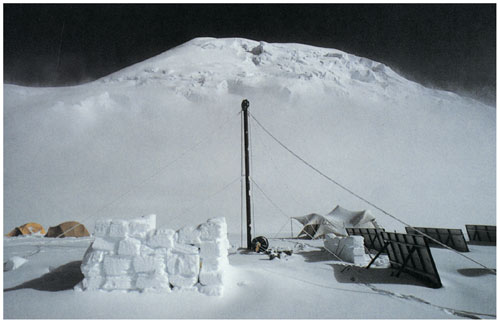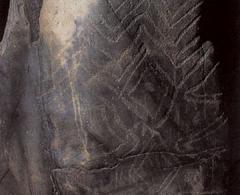
This Article From Issue
May-June 2006
Volume 94, Number 3
Page 276
DOI: 10.1511/2006.59.276
Thin Ice: Unlocking the Secrets of Climate in the World's Highest Mountains. Mark Bowen. xiv + 463 pp. Henry Holt and Company, 2005. $30.
In the summer of 1997, a magazine editor telephoned science writer Mark Bowen to invite him to join paleoclimatologist Lonnie Thompson on the summit of Nevado Sajama, the highest peak in Bolivia (some 6,500 meters above sea level). Bowen, an experienced alpinist with a doctorate in physics, accepted the invitation and linked up with Thompson and his intrepid band just as their ice-drilling equipment was reaching bedrock. The two long ice cores that Thompson's group removed from Sajama were at the time the highest-elevation ice records ever recovered. The year-by-year layering preserved in those ice cores (and in others that have been obtained at high-altitude locations in the tropics) yielded information about the climate in the ancient past—information that has fundamentally changed our view of how Earth's climate system works.
Bowen went on to accompany Thompson on other expeditions, including one to Mount Kilimanjaro in East Africa. In Thin Ice, Bowen has woven accounts of these journeys into a highly readable tale that is equal parts scientific biography, adventure story and history of the science of climate change.
Thompson is a professor of geological sciences at Ohio State University, where he is affiliated with the famed Byrd Polar Research Center. In 1983, he led an expedition of 10 people and a few dozen pack animals to the top of the Quelccaya ice cap in the high Peruvian Andes, where his team removed the first deep ice core ever taken from a tropical glacier. Before that point, drilling into ice caps at high altitudes in the tropics and subtropics had been considered technically unfeasible and scientifically misguided. Willi Dansgaard, one of the founding fathers of ice drilling in polar regions, once told the National Science Foundation in a review of one of Thompson's funding proposals that "Quelccaya is too high for human beings, and the technology does not exist to drill it." Furthermore, back in 1983 it was widely believed that the tropics were climatically stable and were largely uninvolved in climate change. Thompson's results from Quelccaya, however, along with his later data from ice caps elsewhere in the Andes, at several sites on the Tibetan Plateau, and in Africa have convincingly shown that the tropics are climatically volatile, as much so as the poles.
In 2001, Thompson made headlines around the world with his announcement that over the course of the 20th century Kilimanjaro had lost 80 percent of its ice cover, and with his prediction that the remaining ice on the summit would be completely gone by about 2015. On repeat visits to Quelccaya and trips to the remaining ice caps in the tropics, he has documented dramatic melting, which is among the most visible and compelling evidence of global warming. Thompson sees himself as racing against time to recover irreplaceable climate records from the world's rapidly disappearing mountain glaciers.

From Thin Ice.
In his efforts to obtain ice cores, Thompson has spent an enormous amount of time at elevations above 5,500 meters. High-altitude climbers typically tackle a peak by spending time in a series of camps at lower elevations to acclimatize and then making a final rushed push for the summit. But Thompson and his loyal band of colleagues, students and mountain guides spend literally months at a time working at altitude. The work is strenuous and not without danger. For example, during one particularly nasty storm near the top of Huascarán, Peru's highest peak (more than 6,000 meters above sea level), gale-force winds toppled Thompson's tent with him inside, and it began sliding across the frozen surface toward a sheer precipice. With the help of a team member, he avoided plunging over the edge by jamming an ice ax through the floor of the tent. More mundane hardships, including altitude sickness, frostbite and sunburn, have of course also plagued his group.
Historically, drilling programs in Greenland and the Antarctic have been undertaken with massive logistical support—the use of military transport aircraft, convoys of tracked vehicles and the like. In contrast, Thompson and his colleagues have managed to drill into tropical glaciers with nothing more to rely on than a combination of modest funding, low-tech equipment, ingenuity and sheer muscle power. Because the thin air at high altitudes precludes the use of helicopters, all of the drilling equipment and supplies must be carried up and down the slopes by yaks, mules, horses or humans. Thompson's team has designed special lightweight drills that can be broken down for transport. They have also shunned heavy generators and fuel, instead carrying solar panels to the drill site and mounting them there to harness the power of the Sun.
An additional problem faced by those who drill in the tropics is that the ice they have collected melts as they descend to warmer altitudes. Thus they must race to get ice cores off the mountain and into freezers before shipping them back to a repository at the Byrd Polar Research Center. A much-publicized effort in 2000 to move ice cores off the summit of Kilimanjaro using a hot-air balloon was aborted when the Tanzanian government refused to approve the needed permits. Thompson had to hire additional porters to carry the cores down.
Although Bowen's narrative is constructed around Thompson's heroic quest to gain insights into climate behavior, Thin Ice is also a detailed and impressively researched history of the science of climate change, from the theoretical underpinnings of greenhouse science provided in the early 19th century by mathematician Joseph Fourier and chemist Svante Arrhenius, to the 20th-century insights and contributions of Guy Stewart Callendar, Roger Revelle and Charles David Keeling, to the most recent literature on El Niño and the modeling of changes in ocean circulation. Fortunately, what could have been a dry litany of scientific accomplishments is enlivened by tales of personalities and rivalries, competing ideas and struggles for funding, and political debates on the floor of Congress. The result is an entertaining and illuminating account of how science works and of the dangers of its politicization.
A final theme that emerges in Thin Ice is the link between climate change and human history. As paleoclimatologists like Thompson have produced increasingly detailed records of changes over time in temperature and precipitation patterns in the tropics, anthropologists and historians have begun to examine the implications of that research for our understanding of the rise and fall of civilizations. Time after time, dating has produced compelling correlations that argue for the role of climate change as a trigger for societal upheaval. The annual layers of the ice cores from Quelccaya contain evidence of a 300-year-long drought that began about 1150 A.D., which coincides with the collapse of the Tiwanaku civilization around Lake Titicaca. In ice from Kilimanjaro, a prominent dust-rich band indicative of a disastrous drought about 4,200 years ago correlates with the sudden simultaneous collapses of the Old Kingdom of Egypt and the Akkadian Empire in Mesopotamia.
As human activities are increasingly implicated as the primary cause of the current rise in global temperature, the realization that ancient cultures may have succumbed to climate changes may provide valuable lessons for humanity in the face of an uncertain climate future. This is a timely message that deserves our attention. Reading Thin Ice leaves one with an appreciation of how vulnerable we are to climate change and how important it is for future generations that we consider now how to avoid contributing to global warming.

American Scientist Comments and Discussion
To discuss our articles or comment on them, please share them and tag American Scientist on social media platforms. Here are links to our profiles on Twitter, Facebook, and LinkedIn.
If we re-share your post, we will moderate comments/discussion following our comments policy.